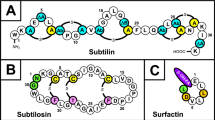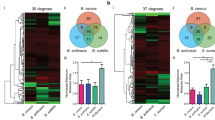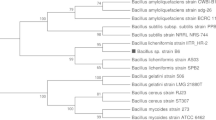Abstract
Petrobactin is the primary siderophore synthesized by Bacillus anthracis str Sterne and is required for virulence of this organism in a mouse model. The siderophore’s biosynthetic machinery was recently defined and gene homologues of this operon exist in several other Bacillus strains known to be mammalian pathogens, but are absent in several known to be harmless such as B. subtilis and B. lichenformis. Thus, a common hypothesis regarding siderophore production in Bacillus species is that petrobactin production is exclusive to pathogenic isolates. In order to test this hypothesis, siderophores produced by 106 strains of an in-house library of the Bacillus cereus sensu lato group were isolated and identified using a MALDI-TOF-MS assay. Strains were selected from a previously defined phylogenetic tree of this group in order to include both known pathogens and innocuous strains. Petrobactin is produced by pathogenic strains and innocuous isolates alike, and thus is not itself indicative of virulence.




Similar content being viewed by others
References
Abergel RJ, Wilson MK, Arceneaux JE, Hoette TM, Strong RK, Byers BR, Raymond KN (2006) Anthrax pathogen evades the mammalian immune system through stealth siderophore production. Proc Natl Acad Sci U S A 103:18499–18503
Barbeau K, Zhang G, Live DH, Butler A (2002) Petrobactin, a photoreactive siderophore produced by the oil-degrading marine bacterium Marinobacter hydrocarbonoclasticus. J Am Chem Soc 124:378–379
Byers BR, Arceneaux JE (1998) Microbial iron transport: iron acquisition by pathogenic microorganisms, vol 35. Marcel Dekker Inc., New York, NY
Casadevall A (2006) Cards of virulence and the global virulome for humans. Microbe 1:359–364
Cendrowski S, MacArthur W, Hanna P (2004) Bacillus anthracis requires siderophore biosynthesis for growth in macrophages and mouse virulence. Mol Microbiol 51:407–417
Challis GL (2005) A widely distributed bacterial pathway for siderophore biosynthesis independent of nonribosomal peptide synthetases. Chembiochem 6:601–611
Daffonchio D, Raddadi N, Merabishvili M, Cherif A, Carmagnola L, Brusetti L, Rizzi A, Chanishvili N, Visca P, Sharp R, Borin S (2006) Strategy for identification of Bacillus cereus and Bacillus thuringiensis strains closely related to Bacillus anthracis. Appl Environ Microbiol 72:1295–12301
Dale SE, Doherty-Kirby A, Lajoie G, Heinrichs DE (2004) Role of siderophore biosynthesis in virulence of Staphylococcus aureus: identification and characterization of genes involved in production of a siderophore. Infect Immun 72:29–37
De Voss JJ, Rutter K, Schroeder BG, Su H, Zhu Y, Barry CE III (2000) The salicylate-derived mycobactin siderophores of Mycobacterium tuberculosis are essential for growth in macrophages. Proc Natl Acad Sci U S A 97:1252–1257
Dhungana S, Anderson DS, Mietzner TA, Crumbliss AL (2005) Kinetics of iron release from ferric binding protein (FbpA): mechanistic implications in bacterial periplasm-to-cytosol Fe3+ transport. Biochemistry 44:9606–9618
Dionis JB, Jenny HB, Peter HH (1991) Therapeutically useful iron chelators. In: Winkelmann G (ed) Handbook of microbial iron chelates. CRC Press, Boca Raton, FL, pp 15–64
Drobniewski FA (1993) Bacillus cereus and related species. Clin Microbiol Rev 6:324–338
Ferreras JA, Rye JS, Di Lello F, Tan DS, Quadri LEN (2005) Small molecule inhibition of siderophore biosynthesis in Mycobacterium tuberculosis and Yersinia pestis. Nat Chem Biol 1:29–32
Griffiths E (1999) Iron in biological systems, 2nd edn. John Wiley, Chichester, UK
Han CS, Xie G, Challacombe JF, Altherr MR, Bhotika SS, Bruce D, Campbell CS, Campbell ML, Chen J, Chertkov O, Cleland C, Dimitrijevic M, Doggett NA, Fawcett JJ, Glavina T, Goodwin LA, Hill KK, Hitchcock P, Jackson PJ, Keim P, Kewalramani AR, Longmire J, Lucas S, Malfatti S, McMurry K, Meincke LJ, Misra M, Moseman BL, Mundt M, Munk AC, Okinaka RT, Parson-Quintana B, Reilly LP, Richardson P, Robinson DL, Rubin E, Saunders E, Tapia R, Tesmer JG, Thayer N, Thompson LS, Tice H, Ticknor LO, Wills PL, Brettin TS, Gilna P (2006) Pathogenomic sequence analysis of Bacillus cereus and Bacillus thuringiensis isolates closely related to Bacillus anthracis. J Bacteriol 188:3382–3390
Hernandez E, Ramisse F, Cruel T, le Vagueresse R, Cavallo JD (1999) Bacillus thuringiensis serotype H34 isolated from human and insecticidal strains serotypes 3a3b and H14 can lead to death of immunocompetent mice after pulmonary infection. FEMS Immunol Med Microbiol 24:43–47
Hill KK, Ticknor LO, Okinaka RT, Asay M, Blair H, Bliss KA, Laker M, Pardington PE, Richardson AP, Tonks M, Beecher DJ, Kemp JD, Kolsto AB, Wong AC, Keim P, Jackson PJ (2004) Fluorescent amplified fragment length polymorphism analysis of Bacillus anthracis, Bacillus cereus, and Bacillus thuringiensis isolates. Appl Environ Microbiol 70:1068–1080
Hoffmaster AR, Ravel J, Rasko DA, Chapman GD, Chute MD, Marston CK, De BK, Sacchi CT, Fitzgerald C, Mayer LW, Maiden MC, Priest FG, Barker M, Jiang L, Cer RZ, Rilstone J, Peterson SN, Weyant RS, Galloway DR, Read TD, Popovic T, Fraser CM (2004) Identification of anthrax toxin genes in a Bacillus cereus associated with an illness resembling inhalation anthrax. Proc Natl Acad Sci U S A 101:8449–8454
Keim P, Kalif A, Schupp J, Hill K, Travis SE, Richmond K, Adair DM, Hugh-Jones M, Kuske CR, Jackson P (1997) Molecular evolution and diversity in Bacillus anthracis as detected by amplified fragment length polymorphism markers. J Bacteriol 179:818–824
Keim P, Price LB, Klevytska AM, Smith KL, Schupp JM, Okinaka R, Jackson PJ, Hugh-Jones ME (2000) Multiple-locus variable-number tandem repeat analysis reveals genetic relationships within Bacillus anthracis. J Bacteriol 182:2928–2936
Koehler TM (2000) Gram-positive pathogens. ASM Press, Washington, DC
Koppisch AT, Browder CC, Moe AL, Shelley JT, Kinkel BA, Hersman LE, Iyer S, Ruggiero CE (2005) Petrobactin is the primary siderophore synthesized by Bacillus anthracis str. Sterne under conditions of iron starvation. Biometals 18:577–585
Kramer JM, Gilbert RJ (1989) Bacillus cereus and other Bacillus species. Marcel Dekker, Inc., New York
Lee JY, Janes BK, Passalacqua KD, Pflegler BF, Bergman NH, Liu H, Hakansson K, Somu RV, Aldrich CC, Cendrowski S, Hanna PC, Sherman DH (2007) Biosynthetic analysis of the petrobactin biosynthetic pathway in Bacillus anthracis. J Bacteriol 189:1698–1710
May JJ, Wendrich TM, Marahiel MA (2001) The dhb operon of Bacillus subtilis encodes the biosynthetic template for the catecholic siderophore 2,3-dihydroxybenzoate-glycine-threonine trimeric ester bacillibactin. J Biol Chem 276:7209–7217
Neilands J (1995) Siderophores: structure and function of microbial iron transport compounds. J Biol Chem 270:26723
Oves-Costales D, Kadi N, Fogg MJ, Song L, Wilson KS, Challis GL (2007) Enzymatic logic of anthrax stealth siderophore biosynthesis: AsbA catalyzes ATP-dependent condensation of citric acid and spermidine. J Am Chem Soc 129:8416–8417
Quadri LE (2007) Strategic paradigm shifts in the antimicrobial drug discovery process of the 21st century. Infect Disord Drug Targets 7:230–237
Rey MW, Ramaiya P, Nelson BA, Brody-Karpin SD, Zaretsky EJ, Tang M, Lopez de Leon A, Xiang H, Gusti V, Clausen IG, Olsen PB, Rasmussen MD, Andersen JT, Jorgensen PL, Larsen TS, Sorokin A, Bolotin A, Lapidus A, Galleron N, Ehrlich SD, Berka RM (2004) Complete genome sequence of the industrial bacterium Bacillus licheniformis and comparisons with closely related Bacillus species. Genome Biol 5:R77
Sergeev N, Distler M, Vargas M, Chizhikov V, Herold KE, Rasooly A (2006) Microarray analysis of Bacillus cereus group virulence factors. J Microbiol Methods 65:488–502
Sneath PHA (1986) Endospore-forming Gram-positive rods and cocci, vol 2. Williams and Wilkins Co., Baltimore, MD
Wilson MK, Abergel RJ, Raymond KN, Arceneaux JE, Byers BR (2006) Siderophores of Bacillus anthracis, Bacillus cereus, and Bacillus thuringiensis. Biochem Biophys Res Commun 348:320–325
Acknowledgements
R.B.R. is supported by the NSF-REU Bioscience and Biotechnology PUSH program for northern New Mexico. We thank Drs. David Fox and Cindy Browder for helpful discussions. This work was supported by a Laboratory Directed Research and Development exploratory research grant. Los Alamos National Laboratory is operated by the University of California for the U.S. Department of Energy under contract W-7405-ENG-36.
Author information
Authors and Affiliations
Corresponding author
Rights and permissions
About this article
Cite this article
Koppisch, A.T., Dhungana, S., Hill, K.K. et al. Petrobactin is produced by both pathogenic and non-pathogenic isolates of the Bacillus cereus group of bacteria. Biometals 21, 581–589 (2008). https://doi.org/10.1007/s10534-008-9144-9
Received:
Accepted:
Published:
Issue Date:
DOI: https://doi.org/10.1007/s10534-008-9144-9




